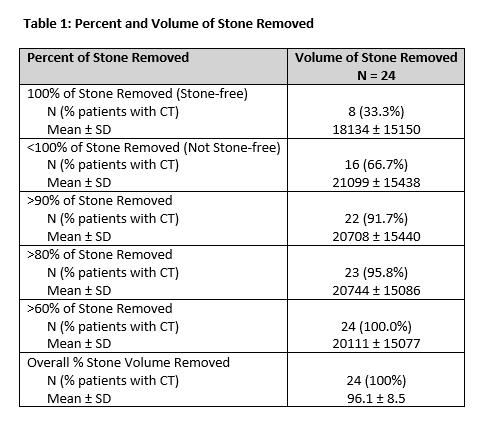Back
Introduction: The surgical management of large stone burdens is a challenge which often necessitates staged ureteroscopy or a more invasive percutaneous nephrolithotomy. The CVAC Aspiration System is a novel, steerable catheter using irrigation and aspiration to evacuate stone debris after laser lithotripsy. This study aims to evaluate the effectiveness of CVAC for treating large renal stones.
Methods: A retrospective, multi-institutional review was performed on patients from 2 major urologic centers with stones larger than 10 mm who underwent ureteroscopy with laser lithotripsy and CVAC outside of an ongoing randomized clinical trial. Categorical variables were summarized using relative frequencies and percentages. Continuous variables were summarized using mean ± standard deviation, median, and minimum and maximum. All statistical analyses were performed using Stata version 17.0.
Results: 43 patients underwent the procedure. Mean pre-operative stone burden was 29 ± 12 mm and mean stone volume 2,500 ± 4000 mm3. Twenty-four patients had CT imaging at follow-up which showed 96.1% ± 8.5% of total stone volume removed. Of those, 33% (8) had no residual stone, 92% (22) had > 90% stone volume removed, 96% (23) had > 80% removed and all had > 60% removed (Table 1). Mean stone volume reduction based on baseline stone burden varied between 94% and 99% (Table 2). Twenty-one patients were anticipated pre-operatively to need a secondary procedure. Of those, 33% (7) were stone-free on imaging after 1 procedure and only 9.5% (2) required a secondary procedure. There were no complications secondary to the device and 1 high-risk patient was admitted post-operatively for a urinary tract infection.
Conclusions: CVAC is a safe and effective procedure for large stone burdens. The procedure drastically reduces stone volume regardless of baseline stone burden and can decrease the need for secondary procedures. SOURCE OF
Funding: Calyxo, inc.


Moderated Poster Session
Session: MP23: Stone Disease: Surgical Therapy (including ESWL) I
MP23-14: Ureteroscopy with CVAC Aspiration System for the Surgical Management of Large Renal Stones
Friday, April 28, 2023
3:30 PM – 5:30 PM CST
Location: S504

Karen Lynne Stern, MD
Associate Professor
Mayo Clinic Arizona
Poster Presenter(s)
Introduction: The surgical management of large stone burdens is a challenge which often necessitates staged ureteroscopy or a more invasive percutaneous nephrolithotomy. The CVAC Aspiration System is a novel, steerable catheter using irrigation and aspiration to evacuate stone debris after laser lithotripsy. This study aims to evaluate the effectiveness of CVAC for treating large renal stones.
Methods: A retrospective, multi-institutional review was performed on patients from 2 major urologic centers with stones larger than 10 mm who underwent ureteroscopy with laser lithotripsy and CVAC outside of an ongoing randomized clinical trial. Categorical variables were summarized using relative frequencies and percentages. Continuous variables were summarized using mean ± standard deviation, median, and minimum and maximum. All statistical analyses were performed using Stata version 17.0.
Results: 43 patients underwent the procedure. Mean pre-operative stone burden was 29 ± 12 mm and mean stone volume 2,500 ± 4000 mm3. Twenty-four patients had CT imaging at follow-up which showed 96.1% ± 8.5% of total stone volume removed. Of those, 33% (8) had no residual stone, 92% (22) had > 90% stone volume removed, 96% (23) had > 80% removed and all had > 60% removed (Table 1). Mean stone volume reduction based on baseline stone burden varied between 94% and 99% (Table 2). Twenty-one patients were anticipated pre-operatively to need a secondary procedure. Of those, 33% (7) were stone-free on imaging after 1 procedure and only 9.5% (2) required a secondary procedure. There were no complications secondary to the device and 1 high-risk patient was admitted post-operatively for a urinary tract infection.
Conclusions: CVAC is a safe and effective procedure for large stone burdens. The procedure drastically reduces stone volume regardless of baseline stone burden and can decrease the need for secondary procedures. SOURCE OF
Funding: Calyxo, inc.


